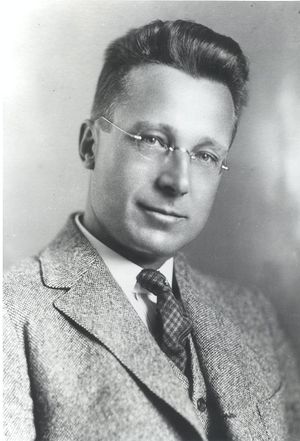John Harold Morecroft: Difference between revisions
No edit summary |
No edit summary |
||
| Line 1: | Line 1: | ||
== | == Biography == | ||
[[Image:2203 - morecroft.jpg|thumb| | [[Image:2203 - morecroft.jpg|thumb|right]] | ||
<p>Born: 19 September 1881 </p> | <p>Born: 19 September 1881 </p> | ||
| Line 13: | Line 13: | ||
<p>During World War I, he was engaged by the U. S. Navy as a scientific expert, and worked on submarine detection schemes; with Professors Pupin and Wills, he developed the supersonic echo method. He was sent to England and France during the latter part of the war as liaison officer for the navy. </p> | <p>During World War I, he was engaged by the U. S. Navy as a scientific expert, and worked on submarine detection schemes; with Professors Pupin and Wills, he developed the supersonic echo method. He was sent to England and France during the latter part of the war as liaison officer for the navy. </p> | ||
<p>He was a [[IEEE Fellow Grade History|Fellow]] of the Institute of Radio Engineers, American Institute of Electrical Engineers, and the American Physical Society, a member of Phi Beta Kappa, Tau Beta Pi, Sigma Xi, and Epsilon Chi. At the 1929 Commencement, Syracuse University invested him with the honorary degree of Doctor of Science. He served as [[Presidents of the Institute of Radio Engineers (IRE)|IRE president]] in 1924. He wrote several books on radio engineering and served on many committees of both the Institute of Radio Engineers and the American Institute of Electrical Engineers, besides carrying on a wide consulting practice. </p> | <p>He was a [[IEEE Fellow Grade History|Fellow]] of the [[IRE History 1912-1963|Institute of Radio Engineers]], [[AIEE History 1884-1963|American Institute of Electrical Engineers]], and the American Physical Society, a member of Phi Beta Kappa, Tau Beta Pi, Sigma Xi, and Epsilon Chi. At the 1929 Commencement, Syracuse University invested him with the honorary degree of Doctor of Science. He served as [[Presidents of the Institute of Radio Engineers (IRE)|IRE president]] in 1924. He wrote several books on radio engineering and served on many committees of both the Institute of Radio Engineers and the American Institute of Electrical Engineers, besides carrying on a wide consulting practice. </p> | ||
[[Category:People and organizations|Morecroft]] [[Category:Engineers|Morecroft]] [[Category:Sonar|Morecroft]] | |||
Revision as of 15:18, 1 February 2012
Biography
Born: 19 September 1881
Died:
John H. Morecroft was born in Staffordshire, England, September 19, 1881. At eight years of age he was brought to the United States by his parents. His early schooling was obtained in the public schools of Syracuse, New York, and later in 1904, he received his E.E. degree from the University of Syracuse. After a year as foreman of a machine shop he spent two years at Syracuse University in the Liberal Arts school from which he was graduated in 1907. During these two years he was an assistant in the engineering school.
From 1907 to 1909 he instructed in the electrical department of the Pratt Institute, spending practically all of his spare time in the laboratory of Dr. M. I. Pupin. In 1909 he became an instructor in electrical engineering at Columbia University, becoming an assistant professor in 1910 and subsequently advancing through the ranks to the position of professor.
During World War I, he was engaged by the U. S. Navy as a scientific expert, and worked on submarine detection schemes; with Professors Pupin and Wills, he developed the supersonic echo method. He was sent to England and France during the latter part of the war as liaison officer for the navy.
He was a Fellow of the Institute of Radio Engineers, American Institute of Electrical Engineers, and the American Physical Society, a member of Phi Beta Kappa, Tau Beta Pi, Sigma Xi, and Epsilon Chi. At the 1929 Commencement, Syracuse University invested him with the honorary degree of Doctor of Science. He served as IRE president in 1924. He wrote several books on radio engineering and served on many committees of both the Institute of Radio Engineers and the American Institute of Electrical Engineers, besides carrying on a wide consulting practice.
